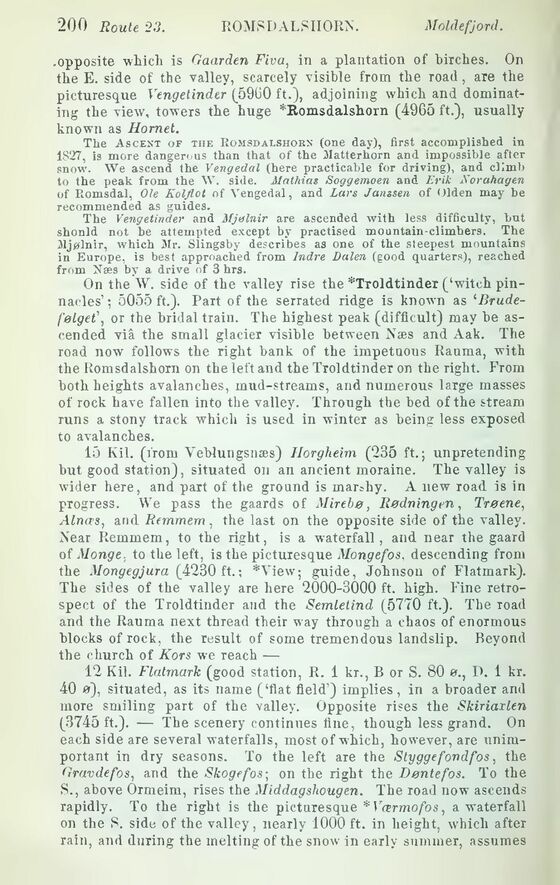
Full resolution (JPEG) - On this page / på denna sida - Norway - Pages ...

<< prev. page << föreg. sida << >> nästa sida >> next page >>
Below is the raw OCR text
from the above scanned image.
Do you see an error? Proofread the page now!
Här nedan syns maskintolkade texten från faksimilbilden ovan.
Ser du något fel? Korrekturläs sidan nu!
This page has never been proofread. / Denna sida har aldrig korrekturlästs.
.opposite which is Gaarden Fiva, in a plantation of birches. On
the E. side of the valley, scarcely visible from the road, are the
picturesque Vengetinder (5960 ft.), adjoining which and
dominating the view, towers the huge *Romsdalshorn (4965 ft.),
usually-known as Hornet.
The Ascext of tiie Romsdalshorx (one day), first accomplished in
1827, is more dangerous than that of the Matterhorn and impossible after
snow. We ascend the Vengedal (here practicable for driving), and climb
to the peak from the W. side. Mathias Soggemoen and Erik Norahagen
of Romsdal, Ole Kclflot of Vengedal, and Lars Janssen of Olden may be
recommended as guides.
The Vengetinder and Mjulnir are ascended with less difficulty, but
shonld not be attempted except by practised mountain-climbers. The
Mjølnir, which Mr. Slingsby describes as one of the steepest mountains
in Europe, is best approached from Indre Dalen (good quarters), reached
from Næs by a drive of 3 hrs.
On the W. side of the valley rise the *Troldtinder (‘witch
pinnacles’ ; 5055 ft.). Part of the serrated ridge is known as
lBrude-følget’, or the bridal train. The highest peak (difficult) may be
ascended via the small glacier visible between Næs and Aak. The
road now follows the right bank of the impetuous Rauma, with
the Romsdalshorn on the left and the Troldtinder on the right. From
both heights avalanches, mud-streams, and numerous large masses
of rock have fallen into the valley. Through the bed of the stream
runs a stony track whicli is used in winter as being less exposed
to avalanches.
15 Kil. (from Veblungsnæs) Horgheim (235 ft.; unpretending
but good station), situated on an ancient moraine. The valley is
wider here, and part of the ground is marshy. A new road is in
progress. We pass the gaards of Mirebø, Rødningen, Trøene,
Alncrs, and Remmem, the last on the opposite side of the valley.
Near Remmem, to the right, is a waterfall, and near the gaard
of Monge. to the left, is the picturesque Mongefos, descending from
the Mongegjura (4230 ft.; *Yiew; guide, Johnson of Flatmark).
The sides of the valley are here 2000-3000 ft. high. Fine
retrospect of the Troldtinder and the Semletind (5770 ft.). The Toad
and the Rauma next thread their way through a chaos of enormous
blocks of rock, the result of some tremendous landslip. Beyond
the church of Kors we reach —
12 Kil. Flatmark (good station, R. 1 kr., B or S. 80 e., D. 1 kr.
40 e), situated, as its name (‘flat field’) implies, in a broader and
more smiling part of the valley. Opposite rises the Skiriaxlen
(3745 ft.). — The scenery continues fine, though less grand. On
each side are several waterfalls, most of which, however, are
unimportant in dry seasons. To the left are the Stygge fond fos, the
Gravdefos, and the Skogefos; on the right the Døntefos. To the
S., above Ormeim, rises the Middagshougen. The road now ascends
rapidly. To the right is the picturesque *Varmofos, a waterfall
on the 8. side of the valley, nearly 1000 ft. in height, which after
rain, and during the melting of the snow in early summer, assumes
<< prev. page << föreg. sida << >> nästa sida >> next page >>